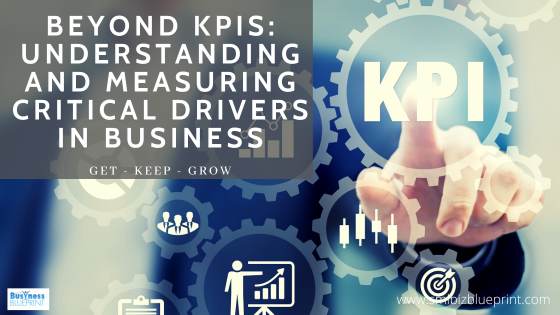In today’s business world, achieving sustainable success demands more than just keeping an eye on traditional Key Performance Indicators (KPIs) like sales, profits, and cash flow. While these metrics provide valuable insights into what has already happened, they need to catch up in predicting future outcomes and guiding strategic decisions.
The real game-changer lies in mastering the art of leveraging critical drivers and predictive analytics to pave the way for enduring business excellence.
This comprehensive guide delves deep into the transformative approach of focusing on the underlying factors that drive performance. By shifting the lens from merely tracking outcomes to understanding and optimising the core activities that lead to those outcomes, businesses can forecast future trends, identify growth opportunities, and mitigate potential risks with unparalleled precision.
Join us as we explore the pivotal role of predictive analytics in crafting a proactive business strategy, the process of pinpointing your organisation’s critical success factors, and the best practices for analysing operational drivers.

#1 Understanding Critical Drivers in Business
In business strategy, critical drivers are the foundational elements that directly influence the success or failure of your enterprise. Unlike traditional KPIs, which often reflect the outcome of various processes and activities, critical drivers are the underlying forces shaping these outcomes. By identifying and optimising these drivers, businesses can exert more direct control over their performance and trajectory.
The Essence of Critical Drivers
A critical driver is any factor that significantly impacts your business’s key objectives, such as customer satisfaction, operational efficiency, market share, or revenue growth. These can range from internal processes like production efficiency and employee engagement to external factors such as market trends and customer behaviour. The key is pinpointing which drivers are most aligned with your strategic goals and has the potential for the most significant impact.
Identifying Your Business’s Critical Drivers
Identifying the correct critical drivers requires a deep understanding of your business model, industry dynamics, and competitive landscape. Start by analysing your value chain and pinpointing areas where improvements can lead to significant performance enhancements.
Engage with stakeholders across different levels of your organisation to gain diverse insights into what drives value and success in your operations.
Data-Driven Decision Making
In today’s digital age, leveraging data analytics is indispensable for uncovering your critical drivers. Data-driven decision-making allows you to sift through vast amounts of information to identify patterns, trends, and correlations that might not be apparent at first glance.
Predictive analytics can forecast future trends based on historical data, providing actionable insights to inform your strategy.
Leveraging Technology for Enhanced Visibility
Advancements in technology have made it easier than ever to monitor and manage critical drivers. IoT devices, for example, can provide real-time data on equipment performance, while CRM systems can offer profound insights into customer interactions and preferences.
Integrating these technologies into your operations, you can better understand your critical drivers and how they interact.
By focusing on critical drivers, businesses can move beyond the retrospective analysis offered by traditional KPIs and embrace a more proactive and strategic approach to management. This shift enhances your ability to respond to current challenges and empowers you to anticipate future opportunities and obstacles, laying the foundation for sustained success.
#2 The Power of Predictive Analytics in Shaping Business Futures
Predictive analytics stands at the forefront of transforming business strategies, enabling organisations to leap from hindsight to foresight. By harnessing the power of historical data and advanced algorithms, predictive analytics provides a window into future trends, behaviours, and outcomes, allowing businesses to make informed decisions that are proactive rather than reactive.
Unlocking Future Insights with Predictive Analytics
Predictive analytics utilises statistical models and machine learning techniques to analyse patterns in historical and current data, offering predictions about future events. This powerful tool can be applied across various aspects of a business, from forecasting customer behaviour and market trends to identifying potential risks and opportunities.
Enhancing Strategic Decision-Making
Incorporating predictive analytics into your business strategy enhances decision-making at all levels. It allows leaders to anticipate changes in the market, understand customer needs better, and optimise operations to meet future demands.
Businesses can strategise with greater confidence and agility by providing a data-backed glimpse into the future.
Integrating Predictive Analytics into Your Business
The integration of predictive analytics into business operations requires a structured approach. Begin by identifying key areas where predictive insights could have a significant impact.
Next, ensure you have the correct data infrastructure to collect and analyse data effectively. Finally, invest in the necessary tools and expertise to develop and interpret predictive models.
Building a Data-Driven Culture
Predictive analytics must be embedded within the organisational culture to transform your business. This means fostering an environment where data-driven insights are valued and inform decision-making processes.
Training and empowering employees to think analytically and embrace data in their daily tasks is crucial for cultivating such a culture.
Predictive analytics is more than just a technological tool; it’s a strategic asset that can redefine how businesses anticipate and navigate the future. By embedding predictive analytics into your strategic planning, you can stay ahead of industry trends and shifts and create a resilient and agile business capable of thriving in an ever-changing landscape.
#3 Identifying Your Business’s Critical Success Factors
Understanding the unique drivers of success in your specific business context is beneficial and imperative for strategic differentiation and competitive advantage.
Critical Success Factors (CSFs) are those core elements a business must get right to thrive in its industry. These factors can vary significantly across different markets and even among competitors within the same sector, reflecting each business’s unique challenges and opportunities.
Unearthing the Foundations of Success
The first step in harnessing the power of CSFs is to identify what they are for your business.
This process involves a deep dive into your business model, market environment, and competitive landscape. It requires understanding your customer base, what they value, and what it takes to satisfy their needs better than anyone else.
For some businesses, innovation and speed to market are critical, while for others, customer service and sales calls might be the linchpins of success.
Industry-Specific Considerations
It’s crucial to recognise that CSFs are not one-size-fits-all. For example, patient care quality and regulatory compliance might be critical in the healthcare industry, whereas innovation speed and intellectual property protection could be paramount in the technology sector. This industry-specific lens ensures businesses focus their resources and strategies on what truly matters for their success.
Guiding Strategic Decisions
Once identified, CSFs serve as a guiding light for strategic planning and decision-making. They help businesses prioritise initiatives, allocate resources, and measure performance in a way that aligns with what is most crucial for their success.
Leveraging CSFs for Competitive Advantage
Identifying CSFs is not just an internal exercise; it’s a strategic tool that can set a business apart from its competitors. By focusing on and excelling in areas that are critical to success, a business can create a unique value proposition that is difficult for competitors to replicate.
This could involve innovating in customer engagement, excelling in supply chain efficiency, or leading in sustainability practices, depending on what is most critical in your industry and business context.
Identifying and focusing on your business’s critical success factors is a powerful approach to strategic planning. It ensures that your business strategies are aligned with what truly drives success in your specific context, enabling you to allocate resources effectively and gain a competitive edge.
The following section will delve into operational drivers analysis, a crucial step towards optimising your business processes and maximising efficiency based on your identified CSFs.

#4 Operational Drivers Analysis: The Key to Optimizing Business Processes
Understanding and optimising the operational drivers that directly influence outcomes is pivotal in the quest for business efficiency and effectiveness. When effectively managed, operational drivers are the foundational elements and processes that can significantly improve productivity, cost savings, and, ultimately, business performance.
Unpacking Operational Drivers
Operational drivers are the actionable levers within a business’s control that can significantly impact performance. These range from manufacturing throughput and inventory levels to customer service response times and quality control processes. The key lies in identifying the most impactful drivers for your business and focusing your optimisation efforts there.
Methodologies for Analysis
One practical approach to analysing operational drivers is process mapping, which involves creating a detailed diagram of the steps involved in a business process. This visual representation helps identify inefficiencies, bottlenecks, and opportunities for streamlining.
Value stream mapping, a lean management tool, takes this further by mapping the process and analysing the value added at each step, highlighting areas for improvement.
Achieving Operational Excellence
Optimising operational drivers often leads to significant efficiency gains. For instance, by analysing and improving inventory management processes, a company can reduce holding costs, minimise stockouts, and improve cash flow.
Similarly, optimising production schedules can increase throughput and reduce overtime costs, contributing directly to the bottom line.
Integrating with Strategic Objectives
The analysis and optimisation of operational drivers should be integrated with the business’s overall strategic objectives rather than occurring in isolation.
For instance, if a business has identified innovation as a critical success factor, its operational drivers should be aligned to support a culture of innovation by optimising R&D processes or enhancing collaboration mechanisms.
By focusing on operational drivers, businesses can unlock new levels of efficiency and performance, paving the way for growth and competitive advantage.
The following section will explore the balance between leading and lagging indicators in performance management, ensuring businesses have a comprehensive view of their operational health and strategic direction.
#5 Balancing Leading and Lagging Indicators for Comprehensive Performance Management
The harmony between leading and lagging indicators is instrumental in business performance management. Leading indicators, being predictive, offer foresight into future performance, while lagging indicators provide a retrospective view, revealing outcomes after they have occurred.
Together, they furnish a holistic picture of a business’s health and trajectory, enabling more informed and strategic decision-making.
Understanding Leading and Lagging Indicators
Leading indicators are forward-looking metrics that signal future events or outcomes before they happen. Examples include customer satisfaction scores, employee engagement levels, and the volume of sales inquiries, all of which can predict future sales trends.
On the other hand, lagging indicators are historical metrics that reflect the results of past actions, such as quarterly sales figures, profit margins, and completed projects.
The Significance of a Balanced Approach
Relying solely on lagging indicators can leave businesses always playing catch-up, reacting to events after they’ve occurred. Incorporating leading indicators allows businesses to anticipate changes and adjust their strategies proactively.
For example, a decline in sales inquiries (a leading indicator) might prompt an early intervention strategy to boost marketing efforts before actual sales dip (a lagging indicator).
Identifying Relevant Indicators
The process begins by identifying the most relevant indicators to your business objectives.
For a retail business, leading indicators include web traffic and conversion rates, while lagging indicators focus on sales volume and inventory turnover. The key is to select indicators that align closely with your strategic goals and can provide actionable insights.
The Balanced Scorecard Approach
The Balanced Scorecard is a strategic planning and management system used to align business activities with the organisation’s vision and strategy, improve internal and external communications, and monitor organisational performance against strategic goals.
It integrates financial measures with other key performance indicators around customer perspectives, internal business processes, and learning and growth, offering a more balanced view of organisational performance.
Integrating leading and lagging indicators into performance management practices enables businesses to understand their current performance and anticipate future trends. This dual focus empowers businesses to be more agile and responsive to changes, setting the stage for sustained success.
The subsequent section will delve into the pivotal role of strategic measurement and analytics in identifying growth opportunities and mitigating risks, furthering the narrative on advanced business management strategies.
#6 Driving Business Growth Through Strategic Measurement and Analytics
In today’s competitive landscape, leveraging strategic measurement and analytics is not just a benefit—it’s necessary to identify growth opportunities and mitigate risks. Integrating analytics into strategic planning enables businesses to make informed decisions backed by data-driven insights, fostering innovation and sustainable growth.
The Critical Role of Strategic Measurement
Strategic measurement systematically tracks performance metrics directly aligned with a business’s strategic goals. This approach ensures that every decision and action aims to achieve long-term objectives rather than merely reacting to short-term fluctuations.
For instance, a company might track new product adoption rates or market penetration metrics as strategic measures of its growth initiatives.
Analytics: The Engine of Informed Decision-Making
Analytics, significantly predictive analytics, is pivotal in transforming raw data into actionable insights. Businesses can forecast future behaviours and outcomes by analysing patterns and trends within the data, enabling proactive strategies.
For example, by analysing customer behaviour data, a business can predict future buying trends and adjust its inventory and marketing strategies accordingly.
Integration into Strategic Planning
Integrating analytics into strategic planning involves aligning data analysis with the company’s vision and objectives. This alignment ensures that analytical insights contribute directly to decision-making processes, enhancing the strategic relevance of the data.
For example, a company might use analytics to assess the potential impact of market changes on its strategic objectives, allowing for timely adjustments to its strategic plan.
Data-Driven Growth Strategies
Businesses that adopt a data-driven approach to strategic planning are better positioned to identify new opportunities for growth and innovation. By leveraging data analytics, companies can uncover untapped markets, customer needs, and operational efficiencies, guiding the development of strategic initiatives that drive growth.
For instance, data analysis might reveal a high demand in a market segment that the company had not previously considered, leading to the development of targeted products or services.
As the business environment evolves, the importance of strategic measurement and analytics in driving growth and innovation cannot be overstated. By embracing a data-driven approach to strategic planning, businesses can enhance their decision-making processes, adapt to changing market conditions, and seize new growth opportunities.
The final section will explore how customer satisfaction can be leveraged as a core driver of business success, further emphasising the importance of a holistic approach to business management.

#7 Leveraging Customer Satisfaction as a Core Business Success Driver
In the contemporary business ecosystem, customer satisfaction emerges as an outcome and a pivotal driver of business success. It’s a potent indicator of future buying behaviours, customer loyalty, and brand advocacy, making it an essential metric for businesses aiming to achieve long-term growth and stability.
The Strategic Value of Customer Satisfaction
Customer satisfaction is intrinsically linked to various aspects of business performance, including repeat purchases, customer retention, and word-of-mouth marketing. High satisfaction levels often increase customer lifetime value and can be a differentiator in competitive markets.
For instance, businesses that deliver superior customer experiences often enjoy higher market share and resilience against competitive pressures.
Measuring and Enhancing Customer Satisfaction
Systematic measurement of customer satisfaction through tools such as Net Promoter Score (NPS), Customer Satisfaction Score (CSAT), and Customer Effort Score (CES) provides businesses with actionable insights into customer perceptions and experiences.
When analysed over time, these metrics can highlight trends, pinpoint areas for improvement, and guide strategic initiatives to enhance customer experiences.
Integrating Customer Feedback into Business Strategies
Incorporating customer feedback into strategic planning is crucial for aligning business operations with customer expectations. This feedback loop can inform product development, service enhancements, and customer service policies, ensuring the business evolves in response to customer needs.
For example, a company might use customer feedback to streamline its support processes, reducing response times and improving overall satisfaction.
Cultivating a Customer-Centric Culture
Creating a culture that places the customer at the heart of business decisions is fundamental to leveraging satisfaction as a success driver. This customer-centric approach encourages every employee, from frontline staff to executives, to consider the impact of their actions on customer satisfaction and to seek continuous improvement in customer interactions.
Elevating customer satisfaction to a core strategic priority enables businesses to build deeper relationships with their customers, fostering loyalty and advocacy that can sustain growth over the long term.
As businesses navigate an increasingly competitive and dynamic marketplace, those listening to, understanding, and acting on customer feedback will be better positioned to thrive. The final section will delve into the evolving landscape of business metrics and the importance of staying ahead of future trends and challenges to ensure sustainable success.
Future Trends: The Evolution of Metrics for Sustainable Business Success
As the business landscape evolves rapidly, driven by technological advancements, changing consumer behaviours, and global economic shifts, businesses’ metrics and approaches to gauge success must also adapt. Staying ahead of these trends is not just beneficial; it’s imperative for long-term sustainability and growth.
#8 Emerging Technologies Shaping New Metrics
Artificial intelligence (AI) and machine learning advancements revolutionise how businesses analyse data and derive insights. These technologies enable the development of more sophisticated predictive models and real-time analytics, allowing businesses to accurately anticipate market changes, customer needs, and potential challenges.
For example, AI-powered customer sentiment analysis can provide deeper insights into customer satisfaction beyond traditional survey methods, enabling more nuanced and proactive strategies.
The Rise of Real-Time Data Analysis
Analysing and acting on data in real-time is becoming a critical business capability. Real-time analytics allow immediate responses to customer interactions, operational issues, and market changes, offering a significant competitive advantage.
This shift necessitates the development of new metrics that can capture and reflect dynamic changes, enabling businesses to be more agile and responsive.
Personalisation and Customer Experience Metrics
As personalisation becomes increasingly important in marketing, sales, and customer service, businesses are developing new metrics to measure and optimise individual customer experiences. These metrics focus on understanding and improving the customer journey at every touchpoint, leveraging data to deliver more relevant, personalised interactions that enhance satisfaction and loyalty.
Sustainability and Social Impact Metrics
There’s a growing emphasis on sustainability and social responsibility in business operations. Metrics that evaluate a company’s environmental impact, social contributions, and governance practices (ESG metrics) are becoming more prevalent.
These metrics reflect a company’s commitment to societal and environmental issues and increasingly influence consumer choices, investment decisions, and regulatory assessments.
Adapting to Changing Consumer Behaviors
Consumer behaviours and expectations constantly evolve, influenced by technological advancements, social trends, and economic factors. Businesses must continually adapt their measurement strategies to capture these changes, using metrics that reflect current consumer priorities and values.
For instance, metrics related to online engagement, digital customer experience, and omnichannel effectiveness are becoming increasingly important in the digital age.
The future of business measurement lies in agility, adaptability, and a forward-looking approach. By embracing new technologies, real-time analytics, personalised customer experience metrics, and sustainability measures, businesses can stay ahead of the curve and navigate the complexities of the modern marketplace.
The concluding section of this post will emphasise the importance of transitioning from traditional KPIs to a broader, more dynamic approach to measurement, ensuring sustainable business success in an ever-changing world.
Conclusion
As we navigate the intricacies of modern business management, it becomes increasingly clear that traditional KPIs, while still valuable, are no longer sufficient to ensure sustainable success.
The dynamic nature of today’s business environment, characterised by rapid technological advancements, shifting consumer behaviours, and a growing emphasis on sustainability, demands a more nuanced and forward-looking approach to measurement.
We’ve explored the importance of predictive analytics and its role in enabling businesses to make proactive decisions, tailoring strategies to align with critical drivers unique to each business. Identifying and focusing on your business’s critical success factors (CSFs) allows for a deeper understanding of what drives success in your specific context, offering a competitive edge in a crowded marketplace.
Operational driver analysis emerged as a critical strategy for optimising business processes, emphasising the importance of actionable insights in achieving operational excellence. The balance between leading and lagging indicators provides a comprehensive view of performance, ensuring businesses are informed by past results and equipped to anticipate future trends.
Strategic measurement and analytics are essential tools for uncovering growth opportunities and mitigating risks, highlighting the need for their integration into strategic planning for informed decision-making. The pivotal role of customer satisfaction as a core business success driver underscores the necessity of systematic measurement and response mechanisms to enhance customer experiences and outcomes.
Looking ahead, we discussed the evolution of metrics to accommodate emerging trends and the importance of agility and adaptability in measurement strategies. The future of business measurement lies in its ability to evolve, embracing new methodologies and technologies to capture the complexities of the modern business landscape.
FAQs
Q1: Why are traditional KPIs no longer sufficient for measuring business success?
A1: Traditional KPIs, such as sales revenue and profit margins, provide valuable insights into past performance but may only partially capture a business’s future potential or resilience. In today’s fast-paced and complex business environment, it’s crucial also to incorporate forward-looking metrics that anticipate changes and opportunities.
Q2: How can predictive analytics enhance business strategy?
A2: Predictive analytics leverages historical data and statistical algorithms to forecast future trends and behaviours. This allows businesses to make proactive decisions, tailor strategies to align with their critical drivers, and stay ahead of market dynamics.
Q3: What are Critical Success Factors (CSFs), and how do they differ across industries?
A3: CSFs are the essential elements that a business must focus on to achieve success. They vary significantly across industries and even among competitors within the same industry, influenced by factors like market demands, technological advancements, and customer preferences.
Q4: Can you explain the importance of balancing leading and lagging indicators?
A4: Balancing leading and lagging indicators provides a comprehensive view of a business’s health. Leading indicators predict future performance and help in proactive decision-making, while lagging indicators offer insights into past performance, confirming the outcomes of strategies and initiatives.
Q5: How does focusing on customer satisfaction drive business success?
A5: Prioritising customer satisfaction can lead to increased loyalty, repeat business, and positive word-of-mouth, which are crucial for long-term success. Systematic measurement and response to customer feedback help businesses identify areas for improvement and enhance overall customer experience.
Q6: What role does operational driver analysis play in business optimisation?
A6: Operational drivers analysis identifies the key factors that directly impact business outcomes. By analysing and optimising these drivers, businesses can improve process efficiency, reduce costs, and enhance product or service quality, leading to better performance and competitiveness.
Q7: How should businesses prepare for the evolving business metrics and analytics landscape?
Q7: Businesses should stay informed about emerging trends, such as AI and machine learning, and be willing to adapt their measurement strategies accordingly. Embracing agility and continuously seeking innovative ways to measure and analyse performance will be vital to navigating future challenges and seizing opportunities.

